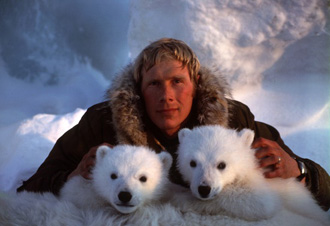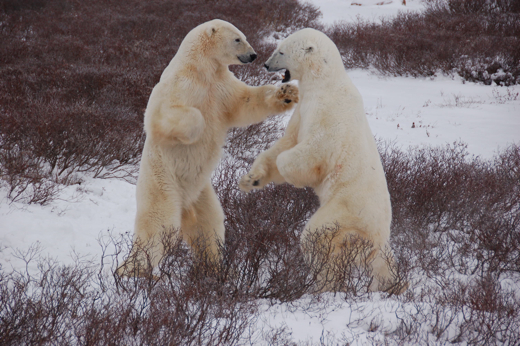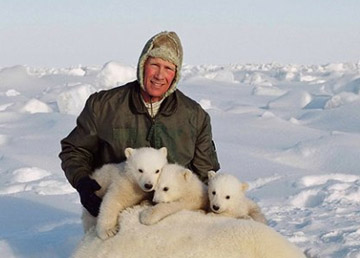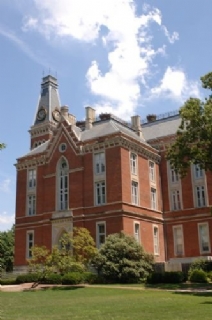Prize-Winning Polar Bear Researcher Steven Amstrup Here for September 30 Lecture
July 17, 2012
 Steven C. Amstrup, chief scientist for Polar Bears International and recipient of the 2012 Indianapolis Prize, will visit the campus of DePauw University on Sunday, September 30, for a public lecture. Dr. Amstrup, who is regarded as the most influential person working on polar bear conservation today, will speak at 3 p.m. in the ballroom of DePauw's Memorial Student Union Building, 408 S. Locust Street [UPDATE 9/16: the location has been changed to Pulliam Center for Contemporary Media, Watson Forum]. The lecture, "Polar Bears and Global Warming: Reliable Predictions and Hope in an Uncertain World," is presented free of admission charge and is open to all. (photo by Daniel J. Cox, Polar Bears International)
Steven C. Amstrup, chief scientist for Polar Bears International and recipient of the 2012 Indianapolis Prize, will visit the campus of DePauw University on Sunday, September 30, for a public lecture. Dr. Amstrup, who is regarded as the most influential person working on polar bear conservation today, will speak at 3 p.m. in the ballroom of DePauw's Memorial Student Union Building, 408 S. Locust Street [UPDATE 9/16: the location has been changed to Pulliam Center for Contemporary Media, Watson Forum]. The lecture, "Polar Bears and Global Warming: Reliable Predictions and Hope in an Uncertain World," is presented free of admission charge and is open to all. (photo by Daniel J. Cox, Polar Bears International)
The Indianapolis Prize is the world's leading award for animal conservation. Amstrup will be presented with the award on September 29, the day before his DePauw appearance, in recognition of his life-long work to transform the world's understanding of and efforts to save polar bears. The presentation will take place at the JW Marriott in downtown Indianapolis.
In 2007 Dr. Amstrup led an international team of researchers to assess the likely future impact of global warming on polar bears. The group's nine reports, relied on by the Secretary of the Interior, became the basis for the 2008 listing of polar bears as a threatened species under the Endangered Species Act. This listing is significant because the polar bear is the first species -- and only species to date -- to be listed on the basis of threats posed by global warming.
as a threatened species under the Endangered Species Act. This listing is significant because the polar bear is the first species -- and only species to date -- to be listed on the basis of threats posed by global warming.
Early in his career as polar bear research leader for the U.S. Geological Survey, Amstrup solved the decades-old mystery of where Alaskan polar bears go to give birth to their young. His finding that more than half of the mother bears denned on drifting ice floes, which are highly susceptible to rising temperatures, was a prescient indication of the vulnerability of polar bears to a warming world. This and other discoveries regarding the polar bear's dependence on sea ice led to Amstrup's 2007 projection that two-thirds of the world's polar bears could disappear by midcentury, and all could be lost by the end of the century, if greenhouse gas emissions continue on the present course. Those discoveries also showed that changing our greenhouse gas emissions path could save polar bears.
"The link between a warmer world and polar bear welfare is very direct -- more direct than probably for any other species," Amstrup recently told Smithsonian. "Their habitat is literally melting. But polar bears are just one of many, many species affected by climate change. So if we act in time to save polar bears, we will have benefited most of the rest of life on earth, including humans."
probably for any other species," Amstrup recently told Smithsonian. "Their habitat is literally melting. But polar bears are just one of many, many species affected by climate change. So if we act in time to save polar bears, we will have benefited most of the rest of life on earth, including humans."
"Steven's fieldwork in the Arctic opened the door to understanding that the deterioration of the polar bear population is at our doorstep, while verifying that this is not an irreversible situation," states Robert Buchanan, president and CEO of Polar Bears International. "His passionate outreach has helped the world understand how sea ice losses from a warming climate threaten polar bear survival. His message is one of hope and determination to have future generations see polar bears roam free in the Arctic."
Adds Michael Crowther, president and CEO of the Indianapolis Zoo, "Steve Amstrup is widely regarded as the most important and influential scientist working on polar bear conservation today. By bringing greater  awareness to the polar bears' plight and plausible solutions, he has created a lifeline for the entire species."
awareness to the polar bears' plight and plausible solutions, he has created a lifeline for the entire species."
Born in Fargo, N.D., Amstrup earned a B.S. in forestry from the University of Washington (1972), a M.S. in wildlife management from the University of Idaho (1975), and a Ph.D. in Wildlife Management from the University of Alaska Fairbanks (1995). He has been conducting research on all aspects of polar bear ecology in the Beaufort Sea since 1980.
Presented by the Indianapolis Zoo, the Indianapolis Prize is an award given every other year to an individual who has made significant strides in conservation efforts involving an animal species or multiple animal species. It includes an unrestricted award of $100,000 and the Lilly Medal. Previous recipients are George W. Archibald (2006), George B. Schaller (2008) and Iain Douglas-Hamilton (2010).
Back